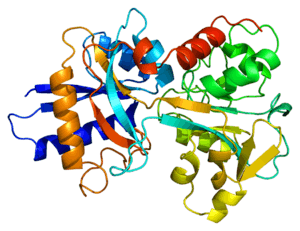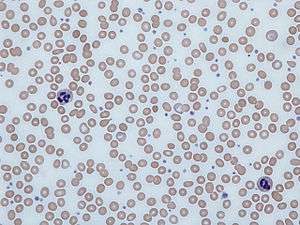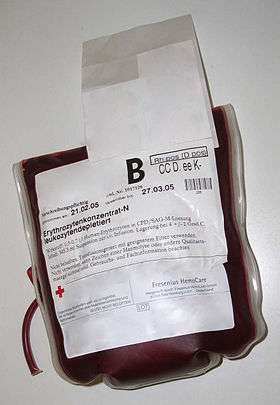Atransferrinemia
Atransferrinemia, not to be confused with hypotransferrinemia, is an autosomal recessive metabolic disorder in which there is an absence of transferrin, a plasma protein that transports iron through the blood.[1][3] Atransferrinemia is characterized by anemia and hemosiderosis in the heart and liver. The iron damage to the heart can lead to heart failure. The anemia is typically microcytic and hypochromic (the red blood cells are abnormally small and pale). Atransferrinemia was first described in 1961 and is extremely rare, with only ten documented cases worldwide.[4]
| Atransferrinemia | |
|---|---|
| Other names | familial atransferrinemia |
 | |
| Atransferrinemia has an autosomal recessive pattern of inheritance, meaning both copies of the gene in each cell are defective. | |
| Causes | Mutations in the TF gene[1] |
| Diagnostic method | TF level, Physical exam[1] |
| Treatment | Oral iron therapy[2] |
Symptoms and signs
The presentation of this disorder entails anemia, arthritis, hepatic anomalies, and recurrent infections are clinical signs of the disease.[5] Iron overload occurs mainly in the liver, heart, pancreas, thyroid, and kidney [6]
Genetics

In terms of genetics of atransferrinemia researchers have identified mutations in the TF gene as a probable cause of this genetic disorder in affected people.[1]
Transferrin is a serum transport protein that transports iron to the reticuloendothelial system for utilization and erythropoiesis, since there is no transferrin in atransferrinemia, serum free iron cannot reach reticuloendothelial cells and there is microcytic anemia.[7][8][9] Also, this excess iron deposits itself in the heart, liver and joints, and causes damage. Ferritin, the storage form of iron gets secreted more into the bloodstream so as to bind with the excessive free iron and hence serum ferritin levels rise in this condition
Diagnosis

The diagnosis of atransferrinemia is done via the following means to ascertain if an individual has the condition:[1]
- Blood test(for anemia)
- TF level
- Physical exam
- Genetic test
Types
There are two forms of this condition that causes an absence of transferrin in the affected individual:[10]
- Acquired atransferrinemia
- Congenital atransferrinemia
Treatment

In terms of treatment of atransferrinemia, iron supplements (oral iron therapy) are the preferred choice, one finds that RBC transfusions are very infrequently needed.[2]
See also
- Transferrin
References
- RESERVED, INSERM US14 -- ALL RIGHTS. "Orphanet: Congenital atransferrinemia". www.orpha.net. Retrieved 2017-02-20.
- Hoffman, Ronald; Jr, Edward J. Benz; Silberstein, Leslie E.; Heslop, Helen; Weitz, Jeffrey; Anastasi, John (2012). Hematology: Diagnosis and Treatment. Elsevier Health Sciences. p. 443. ISBN 978-1455740413.
- "OMIM Entry - # 209300 - ATRANSFERRINEMIA". omim.org. Retrieved 19 February 2017.
- "Atransferrinemia". National Organization for Rare Disorders. Retrieved 20 February 2017.
- "Atransferrinemia | Genetic and Rare Diseases Information Center (GARD) – an NCATS Program". rarediseases.info.nih.gov. Retrieved 2017-02-20.
- Barton, James C.; Edwards, Corwin Q. (2001). Hemochromatosis: Genetics, Pathophysiology, Diagnosis and Treatment. 212: Cambridge University Press. ISBN 9780521593809.
- Bartnikas, Thomas Benedict (1 August 2012). "Known and potential roles of transferrin in iron biology". BioMetals. 25 (4): 677–686. doi:10.1007/s10534-012-9520-3. PMC 3595092. PMID 22294463.
- Reference, Genetics Home. "TF gene". Genetics Home Reference. Retrieved 2017-02-20.
- "OMIM Entry - * 190000 - TRANSFERRIN; TF". omim.org. Retrieved 20 February 2017.
- Marks, Vincent; Mesko, Dusan (2002). Differential Diagnosis by Laboratory Medicine: A Quick Reference for Physicians. Springer Science & Business Media. p. 633. ISBN 9783540430575. Retrieved 20 February 2017.
Further reading
- Handin, Robert I.; Lux, Samuel E.; Stossel, Thomas P. (2003-01-01). Blood: Principles and Practice of Hematology. Lippincott Williams & Wilkins. ISBN 9780781719933.
- Mazza, Joseph (2002-01-01). Manual of Clinical Hematology. Lippincott Williams & Wilkins. ISBN 9780781729802.
External links
| Classification |
|---|